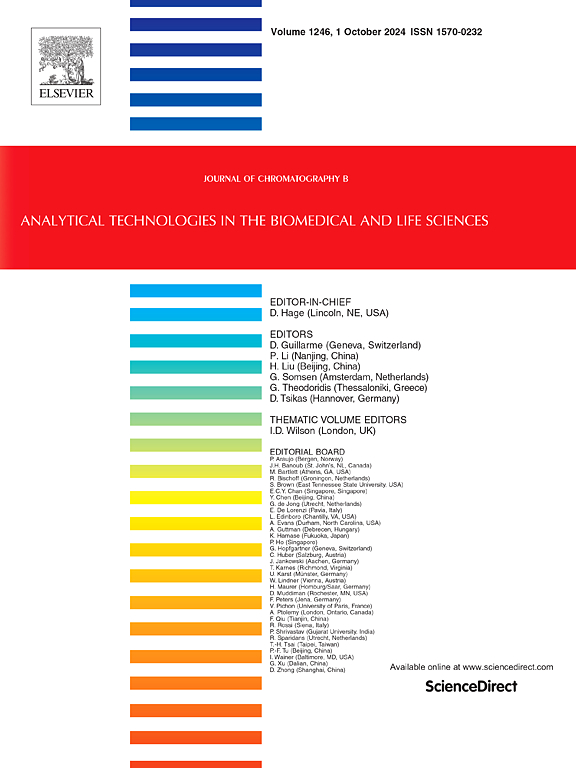基于氧化石墨烯和共价有机骨架复合材料的磁分散固相萃取和定量呼出液中芬太尼的LC-MS/MS分析。
IF 2.8
3区 医学
Q2 BIOCHEMICAL RESEARCH METHODS
引用次数: 0
摘要
游离芬太尼对其药理作用负责,但其总浓度通常用于治疗药物监测目的。确定芬太尼浓度有助于减少处方剂量,减少副作用,提高疗效。因此,预测游离药物浓度在药物研究中是至关重要的。本研究的目的是测定呼出液中游离芬太尼。采用由氧化石墨烯、磁性氧化铁纳米颗粒和共价有机骨架组成的新型吸附剂,采用分散微固相萃取法提取样品。将吸附剂10 mg加入到调整pH为10的样品溶液中。超声5分钟后,用外磁铁分离吸附剂。然后用乙腈、甲醇和去离子水的混合物以42.5:42.5:15 (v/v/v)的比例从吸附剂表面洗脱被吸附的分析物,使用液相色谱-串联质谱系统进行分析。在0.17 ~ 10000 μg -1范围内线性良好,测定系数为0.9998,重复性好,相对标准偏差为4.1%。该方法低检出限为0.05 μg L-1,定量限为0.17 μg L-1。本文章由计算机程序翻译,如有差异,请以英文原文为准。
Extraction and quantitation of fentanyl in exhaled breath condensate using a magnetic dispersive solid phase based on graphene oxide and covalent organic framework composite and LC-MS/MS analysis
Free fentanyl is responsible for its pharmacological effects, but its total concentration is typically determined for therapeutic drug monitoring purposes. Determination of fentanyl concentration can help reduce the prescribed doses, leading to fewer side effects and increased effectiveness. Therefore, predicting free drug concentration in pharmaceutical research is crucial. The aim of this study was to determine free fentanyl in exhaled breath condensate. These samples were extracted using a dispersive micro solid phase extraction method with a new adsorbent made of graphene oxide, magnetic iron oxide nanoparticles, and covalent organic framework. 10 mg of the adsorbent was added to the sample solution adjusted to pH 10. After sonication for 5 min, the sorbent was separated using an external magnet. The adsorbed analyte was then eluted from the sorbent surface using a mixture of acetonitrile, methanol, and deionized water in a ratio of 42.5:42.5:15 (v/v/v) and analyzed using liquid chromatography-tandem mass spectrometry system. The calibration curve showed high linearity in the range of 0.17–10000 μg L−1 with a coefficient of determination of 0.9998 and good repeatability with a relative standard deviation of 4.1 %. Additionally, this method provided a low detection limit of 0.05 μg L−1 and quantification limit of 0.17 μg L−1.
求助全文
通过发布文献求助,成功后即可免费获取论文全文。
去求助
来源期刊

Journal of Chromatography B
医学-分析化学
CiteScore
5.60
自引率
3.30%
发文量
306
审稿时长
44 days
期刊介绍:
The Journal of Chromatography B publishes papers on developments in separation science relevant to biology and biomedical research including both fundamental advances and applications. Analytical techniques which may be considered include the various facets of chromatography, electrophoresis and related methods, affinity and immunoaffinity-based methodologies, hyphenated and other multi-dimensional techniques, and microanalytical approaches. The journal also considers articles reporting developments in sample preparation, detection techniques including mass spectrometry, and data handling and analysis.
Developments related to preparative separations for the isolation and purification of components of biological systems may be published, including chromatographic and electrophoretic methods, affinity separations, field flow fractionation and other preparative approaches.
Applications to the analysis of biological systems and samples will be considered when the analytical science contains a significant element of novelty, e.g. a new approach to the separation of a compound, novel combination of analytical techniques, or significantly improved analytical performance.
 求助内容:
求助内容: 应助结果提醒方式:
应助结果提醒方式:


